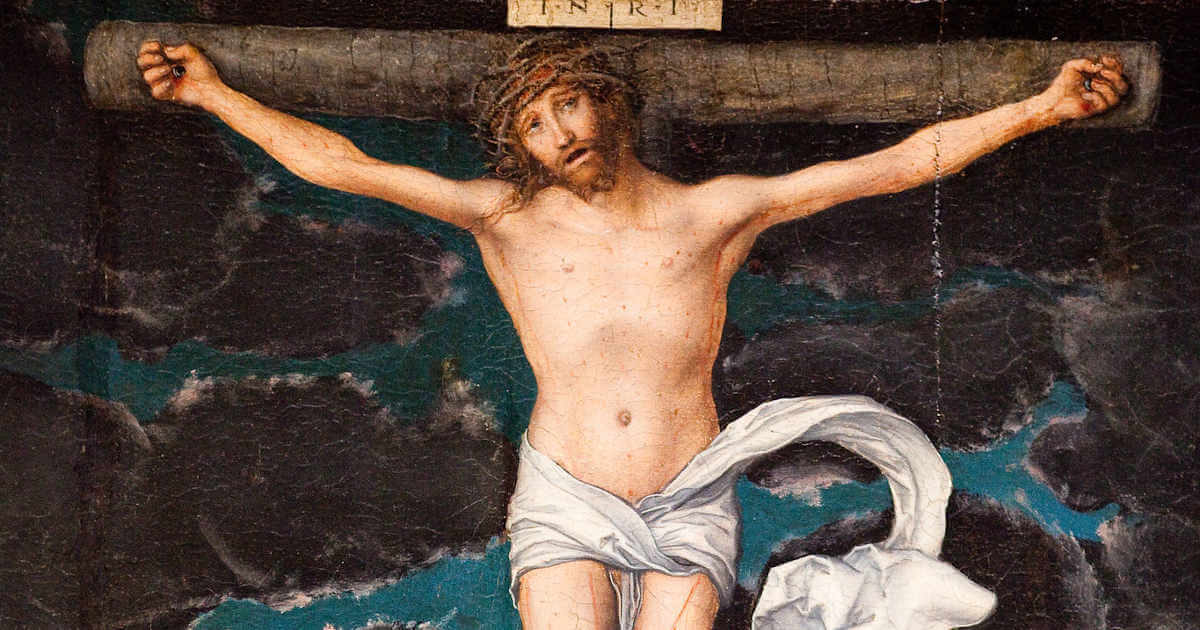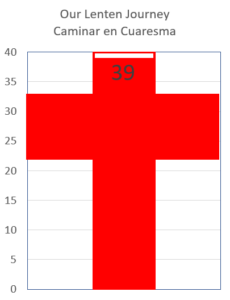

Our Lenten Journey / Caminar en Cuaresma
versión en español
Good Friday – April 7 – Day 39
The Greatest Act of Love Unfolds
Then he handed him over to them to be crucified. So they took Jesus, and, carrying the cross himself, he went out to what is called the Place of the Skull, in Hebrew, Golgotha. There they crucified him, and with him two others, one on either side, with Jesus in the middle. John 19:16–18
The Passion of our Lord begins. Our Gospel narrative today begins with Jesus going out to a garden with His disciples after the celebration of the Passover meal. It’s shocking to consider that the Second Person of the Most Holy Trinity permitted such injustice to befall Him. Though perfect in every way, He allowed Himself to be treated as a criminal, to suffer at the hands of sinners, and to die an agonizing death.
One of the first shocking events to take place in the Garden where Jesus was arrested was the sheer number of soldiers sent to arrest Him. A “band of soldiers” could mean that as many as 600 soldiers were sent to accomplish this deed. Going out with “lanterns, torches and weapons” reveals that it was dark. The symbolism of darkness is significant in John’s Gospel, portraying the spiritual darkness that permeated that night. Within that darkness, one of Jesus’ own Apostles betrayed Him, leading this massive number of soldiers to arrest Him.
Upon Jesus’ arrest, Peter, the soon-to-be leader of the Apostles, denies, for the first time, that he even knows Jesus. This happens while Jesus is interrogated by Annas, a respected former High Priest. The fact that a High Priest was the first to question Jesus shows that even those who are “religious” can, at times, be brutal instruments of attacks upon the faith. After Annas, Jesus is brought to Caiaphas, then acting as High Priest. During that interrogation, Peter denied our Lord a second time and then a third. These religious leaders concluded that Jesus must die. Recall that Caiaphas had previously argued that “it is better for you that one man should die instead of the people” (John 11:50). In fact, those words of Caiaphas were an unintended prophecy, predicting the death of our Lord for all the people.
Since the Jewish authorities did not have the power to crucify someone, they relied on the Roman governor Pilate. Although Pilate shows little interest in meeting their request, He does so out of fear of an uprising and reprisals from Caesar. Pilate also humiliates Jesus, scourging Him and permitting his soldiers to mock Him. Little did they know that the purple cloak with which they covered Jesus and the crown of thorns they placed on His head were symbols of Jesus’ true Kingship, exercised by His defeat of death itself in the battle for the salvation of souls.
When Jesus was crucified, He hung on the Cross between two thieves. As He agonized for three hours, He permitted His mother to stand by Him, entrusted her to the disciple John and John to her, drank of the wine to quench His thirst, spoke His final words, “It is finished,” and then He bowed His sacred head and handed over His spirit.
John’s Gospel relates to us that after Jesus was dead, a soldier pierced His side with a lance, and blood and water flowed out. This final gift from our Lord has been understood as a symbol of the Sacraments of Baptism and the Eucharist. It was truly finished. The King had won the battle. Death was defeated, and the means by which we are to share in that victory was given by the institution of the Sacraments.
Reflect, today, upon this most sacred scene. There is no end to the depth and breadth of the meaning of every action that took place that holy day. Every detail reveals the love of God. Every symbol points to the reality of what took place. Every word our Lord spoke is for us to hear, to receive and to believe. The meaning of Good Friday is beyond our human comprehension. Nonetheless, on this holy day we are called to prayerfully penetrate the meaning of this perfect act of love, so that we will more fully share in the grace given to us by our Lord.
Let us pray:
My crucified Lord, from the perspective of human beings, Your death was horrific. But from the perspective of Your Father in Heaven, Your death was the glorious fulfillment of His will. Through Your Passion and death, You exercised Your Kingship by taking authority over sin and death and commanding it to cease. May I stand with Your dear mother this day, dear Lord, and gaze with gratitude and awe on what You have done for me.
Source: mycatholic.life
USCCB Daily Readings: bible.usccb.org/bible/readings/040723.cfm
Viernes Santo – 7 de abril – Día 39
El mayor acto de amor se desarrolla
Luego se lo entregó para que lo crucificaran. Entonces tomaron a Jesús, y, llevando él mismo la cruz, salió al lugar que se llama el Lugar de la Calavera, en hebreo, Gólgota. Allí lo crucificaron, y con él a otros dos, uno a cada lado, con Jesús en medio. Juan 19:16–18
Comienza la Pasión de Nuestro Señor. Nuestra narración evangélica de hoy comienza con Jesús saliendo a un jardín con sus discípulos después de la celebración de la cena de Pascua. Es impactante considerar que la Segunda Persona de la Santísima Trinidad permitió que tal injusticia le sucediera. Aunque perfecto en todos los sentidos, se permitió ser tratado como un criminal, sufrir a manos de los pecadores y sufrir una muerte agonizante.
Uno de los primeros eventos impactantes que tuvo lugar en el Jardín donde Jesús fue arrestado fue la gran cantidad de soldados enviados para arrestarlo. Una “banda de soldados” podría significar que se enviaron hasta 600 soldados para lograr este hecho. Salir con “linternas, antorchas y armas” revela que estaba oscuro. El simbolismo de la oscuridad es significativo en el Evangelio de Juan, retratando la oscuridad espiritual que impregnaba esa noche. Dentro de esa oscuridad, uno de los propios apóstoles de Jesús lo traicionó, lo que llevó a esta gran cantidad de soldados a arrestarlo.
Tras el arresto de Jesús, Pedro, el futuro líder de los Apóstoles, niega, por primera vez, que conoce a Jesús. Esto sucede mientras Jesús es interrogado por Anás, un ex Sumo Sacerdote respetado. El hecho de que un Sumo Sacerdote fuera el primero en interrogar a Jesús muestra que incluso aquellos que son “religiosos” pueden, a veces, ser instrumentos brutales de ataques a la fe. Después de Anás, Jesús es llevado ante Caifás, actuando entonces como Sumo Sacerdote. Durante ese interrogatorio, Pedro negó a nuestro Señor una segunda vez y luego una tercera. Estos líderes religiosos concluyeron que Jesús debe morir. Recuerde que Caifás había argumentado anteriormente que “mejor te es que muera un hombre en lugar del pueblo” (Juan 11:50). De hecho, esas palabras de Caifás fueron una profecía no intencionada, prediciendo la muerte de nuestro Señor para todo el pueblo.
Como las autoridades judías no tenían el poder de crucificar a alguien, confiaron en el gobernador romano Pilato. Aunque Pilato muestra poco interés en atender su pedido, lo hace por temor a un levantamiento y represalias de César. Pilato también humilla a Jesús, azotándolo y permitiendo que sus soldados se burlen de Él. Poco sabían que el manto púrpura con el que cubrieron a Jesús y la corona de espinas que pusieron sobre Su cabeza eran símbolos de la verdadera Realeza de Jesús, ejercida por Su derrota de la muerte misma en la batalla por la salvación de las almas.
Cuando Jesús fue crucificado, colgó de la Cruz entre dos ladrones. Mientras agonizaba durante tres horas, permitió que Su madre estuviera junto a Él, se la confió al discípulo Juan y a Juan a ella, bebió del vino para saciar Su sed, pronunció Sus últimas palabras: “Consumado es”, y luego Él inclinó Su sagrada cabeza y entregó Su espíritu.
El Evangelio de Juan nos relata que después de la muerte de Jesús, un soldado le abrió el costado con una lanza, y brotó sangre y agua. Este último don de nuestro Señor se ha entendido como un símbolo de los Sacramentos del Bautismo y la Eucaristía. Estaba realmente terminado. El rey había ganado la batalla. La muerte fue derrotada, y el medio por el cual debemos compartir esa victoria fue dado por la institución de los Sacramentos.
Reflexiona, hoy, sobre esta santísima escena. No hay fin a la profundidad y amplitud del significado de cada acción que tuvo lugar ese día sagrado. Cada detalle revela el amor de Dios. Cada símbolo apunta a la realidad de lo que sucedió. Cada palabra que habló nuestro Señor es para que la escuchemos, la recibamos y la creamos. El significado del Viernes Santo está más allá de nuestra comprensión humana. Sin embargo, en este día santo estamos llamados a penetrar en oración el significado de este acto perfecto de amor, para que podamos participar más plenamente de la gracia que nos ha dado nuestro Señor.
Oremos:
Mi Señor crucificado, desde la perspectiva de los seres humanos, Tu muerte fue horrible. Pero desde la perspectiva de Tu Padre Celestial, Tu muerte fue el cumplimiento glorioso de Su voluntad. A través de Tu Pasión y muerte, Tú ejerciste Tu Reinado al tomar autoridad sobre el pecado y la muerte y al ordenarles que cesaran. Que pueda estar con Tu querida madre este día, querido Señor, y contemplar con gratitud y asombro lo que has hecho por mí.
Lecturas de Hoy: bible.usccb.org/es/bible/lecturas/040723.cfm